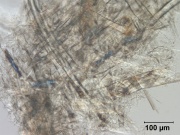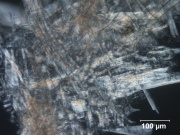Difference between revisions of "Mechanical wood pulp"
m (→Description) |
m (→Description) |
||
| Line 2: | Line 2: | ||
== Description == | == Description == | ||
| − | A mass of wood fibers produced by physically grinding rather than chemically treatment. To produce mechanical wood pulp, bark-free, cut wood is sent to a sandstone abrasion-type grinding machine. It is then screened and filtered to remove large pieces and foreign material. The resultant pulp contains [[lignin]], [[hemicellulose]], [[resin]], and colouring materials which yellow and deteriorate the paper over time. Thus, the pulp is often bleached with [[peroxide]] or | + | A mass of wood fibers produced by physically grinding rather than chemically treatment. To produce mechanical wood pulp, bark-free, cut wood is sent to a sandstone abrasion-type grinding machine. It is then screened and filtered to remove large pieces and foreign material. The resultant pulp contains [[lignin]], [[hemicellulose]], [[resin]], and colouring materials which yellow and deteriorate the paper over time. Thus, the pulp is often bleached with [[peroxide]] or hydrosulfite to improve whiteness. Groundwood paper is produced from coniferous trees. It is inexpensive and has low strength but high opacity and bulk. It is used for newsprint and other low cost printing papers. Groundwood paper is chemically unstable. |
[[File:98_Mechanical softwood_200X_pol adj.jpg|thumb|Mechanical softwood]] | [[File:98_Mechanical softwood_200X_pol adj.jpg|thumb|Mechanical softwood]] | ||
Revision as of 07:31, 1 July 2014
Description
A mass of wood fibers produced by physically grinding rather than chemically treatment. To produce mechanical wood pulp, bark-free, cut wood is sent to a sandstone abrasion-type grinding machine. It is then screened and filtered to remove large pieces and foreign material. The resultant pulp contains Lignin, Hemicellulose, Resin, and colouring materials which yellow and deteriorate the paper over time. Thus, the pulp is often bleached with Peroxide or hydrosulfite to improve whiteness. Groundwood paper is produced from coniferous trees. It is inexpensive and has low strength but high opacity and bulk. It is used for newsprint and other low cost printing papers. Groundwood paper is chemically unstable.
Synonyms and Related Terms
mechanical wood-pulp; groundwood pulp
Other Properties
Tests used to determine the presence of mechanical wood pulp in a paper are: 1) iodine-zinc chloride test gives a positive yellow, 2) aniline sulfate turns yellow for positive, 3) paranitroaniline turns orange and 4) phloroglucinol turns red (Roberts and Etherington 1982).
Additional Information
Matt Roberts, Don Etherington, Bookbinding and the Conservation of Books: a Dictionary of Descriptive Terminology, U.S. Government Printing Office, Washington DC, 1982
Authority
- R. J. Gettens, G.L. Stout, Painting Materials, A Short Encyclopaedia, Dover Publications, New York, 1966
- Matt Roberts, Don Etherington, Bookbinding and the Conservation of Books: a Dictionary of Descriptive Terminology, U.S. Government Printing Office, Washington DC, 1982
- Encyclopedia Britannica, http://www.britannica.com Comment: "Papermaking." Encyclopædia Britannica. 15 July 2004 .

